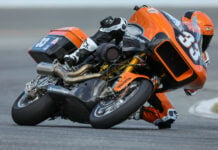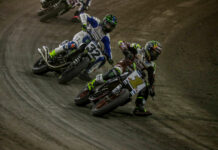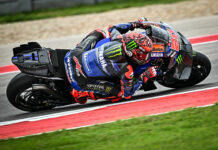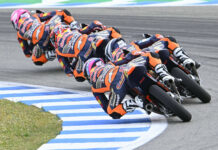Copyright 2003, Roadracing World Publishing, Inc.
Roadracingworld.com sat down with AMA Pro Racing CEO Scott Hollingsworth at the end of the race weekend at Barber Motorsports Park in Birmingham, Alabama and followed up with a phone interview a few days later to talk about the current status of the AMA Superbike series with regards to the 2004 rules package and class structure.
Roadracingworld.com: Where are we at right now on the rules for 2004?
Scott Hollingsworth: We’ve announced a set of technical rules for Superbike. There are a couple of detail issues that still need to be worked out on that. We’re well on our way. I spent some time this weekend trying to finalize those issues. For the most part, the makeup of Superbike is set, and has been for a little while.
Our other classes, the class structures have already been set. Most of the technical issues have been put out for 30-day comment. That comment period is closed.
We’ve got a couple of issues that seem to be at the tip of everyone’s tongues. One is the rider restriction possibility in Superstock. The other is the use of slick tires in Superstock also.
Most of the other technical issues that we’ve been discussing – there’s no big change in Supersport, so that’s not a real big issue. The move from large-displacement bikes to 600s and the twin 750s and the like in Formula Xtreme is met with general favor. So that’s pretty much set. There’s always some small issues to deal with there, but that’s pretty good. Those other two issues seem to be the ones that are really on everybody’s…that everybody’s got an opinion about.
RW: What is the debate on the use of slick tires in Superstock?
SH: There have just been some discussion about it. Everybody has a perspective on it, and they shared their thoughts. We’re just going to make a decision based upon on all the input as to which way we’re going to go. We proposed [to] put the Superstock class on slicks, and that had gone out for a 30-day comment. There have been comments. We’ll assess those and make a decision.
RW: We talked to all the tire manufacturers in the paddock. Representatives from Pirelli, Michelin and Bridgestone all said they hadn’t been consulted by AMA Pro Racing before the proposal for slicks in Superstock was announced. Is that true?
SH: No. I think there have been conversations with some or all of those. The fact of the matter is when we put it out for a comment period they’re all welcome to submit comments. I don’t know that any have, formally, but we still had conversations with other tire manufacturers, Dunlop and other tire manufacturers, about this.
RW: Formula Xtreme, where do two-strokes stand as far as 2004?
SH: They’re out, and that came from the input from the 30-day period and other places. Just general input since we’ve announced that class structure. Even many of the 250 GP riders said they didn’t even want to pursue that. There were a couple of teams that could have pursued it and made a reasonable go out of it, but for the most part the feedback was we’d rather not even try it. So we took them out.
RW: What about ex-Pro Thunder Buells in Formula Xtreme?
SH: Pro Thunder Buells are going to stay in. They were in. There are some people who want us to take them out. Some of the feedback is to take them out. We’re not predisposed to take them out. It hasn’t been finalized, frankly. But some of the comments have been for us to take them out, but we feel they should be in there.
RW: Suzuki’s Mel Harris says he would rather see the Superstock class remain a 750cc class. What are your thoughts on that?
SH: We talked to the manufacturers going back even two years or more about where are they going with sportbikes in the future, and the clear answer was 600s and 1000s. So you’ve seen our rules evolve over the past two seasons now towards focusing on marketing 600c and 1000s. If you look at it, you have a class that still allows a 750 to still be run in Superstock but has 1000s in it without a lot of modifications.
We’ve got 1000cc-based Superbikes. You’ve got 600cc Supersport, which is a great class. Now you’ve got Formula Xtreme based on 600s for the most part. Going backwards, we’ve focused on those two classes.
He’s got a platform. Suzuki has a platform to market their 750cc, that’s Superstock. They have a platform to market their 1000cc, that’s Superbike. They’ve got a platform to market their 600cc. So they can market their whole line of product with us.
RW: Isn’t there a little repetition there? Two classes for 1000cc bikes, two classes for 600cc bikes?
SH: There is, but that’s what the sportbike market in America is, too. So we have to reflect what the marketing trends, what they are. And that’s what they are. Suzuki is the only major manufacturer making a 750. We’ve consistently tried to pare down the number of classes we’re running so we can focus more on our operations, running them better, safety, all those kinds of things. You can’t just develop classes for one brand or one displacement category.
RW: The entry restrictions for Superstock, what’s your intent there?
SH: We’re trying to accomplish a couple of things. One, we have to address this ongoing issue of people using other classes for practice, using the qualifying time but then not taking the grid spot. We’ve got to find a way to stop that practice.
Second one is, we believe, and we proposed this, that there needs to be a place for independent teams, private teams to come race where they don’t have to face the full onslaught of the factory rider competition. And it’s not a place for beginning riders, but for developing riders, an Opie Caylor type, if you want to pick a name, to showcase his talent and see if he can’t move his career forward. And he needs to be able to do that in a manner in which he can showcase his talent.
Those were the two principal reasons we put that out there for comment, and there has been a lot of comment on it. I think some of the independent teams really like it, and some of the factory teams really don’t like it. We’re going to have more discussions on that before we make a final decision.
RW: So you would restrict guys like Aaron Yates and Eric Bostrom from running in Superstock but allow guys like Jamie Hacking and Damon Buckmaster in Superstock?
SH: That was the basic proposal that we put out. We would restrict a few of the current top Superbike riders from competing in Superstock.
RW: What are the rule details that are still being worked out in Superbike?
SH: They principally revolve around the very minute details of what you can and can’t do to stock airboxes or stock throttle bodies. There’s all kinds of little issues that have got to be finalized, but we’re going to be announcing those very soon. So it’s nothing overly significant; it’s detail.
RW: Superbike technical regulations, they are basically set, but still seem to be a hot topic of conversation. Particularly, Mat Mladin points out that the bikes are pretty competitive right now and that the new rules [restricting 1000cc Fours to stock airboxes and throttle bodies] would put him at a disadvantage to the 1000cc V-twins. What are your thoughts on that?
SH: I understand where Mat’s coming from. If you look at it right now, you could say it is fairly well balanced. Most people believe that this next generation of 1000cc Multis is going to be a step ahead of where we are today. And certainly they’re earlier in their development curve than they are for Twins. Over the course of time you’re going to find that the Multis will be very competitive. Suzuki, in particular, may not have a bike for ’04 that’s a lot different than their ’03 bike. But I suspect in ’05, when their normal cycle of updating their models, it will take a dramatic step forward. I suspect the brand new Yamaha, Kawasaki and Hondas will be a step forward from where we are today.
There’s a couple of things we said as objectives. One is we didn’t want Superbikes to get faster than they are today. It’s possible to take the opportunity to reign them in a little bit. We’ve got racetracks that we could out grow if these Superbikes just keep getting faster and faster and faster. So we need to see what we can do today to make this 1000cc platform last as long as it can into the future without obsoleting our racetracks. So that was a principal objective.
The other one was to keep costs contained. So anybody with the capability could put together a competitive Superbike. I think we’ve done that. It’s up to us now that if the Twin is overly competitive it’s up to us to make sure we continue to balance the competition just like we have this year.
If you recall a year ago, there was outcry about the rules we imposed for ’03 too, and it’s turned out to be very good rules. The Kawasaki won a race and was leading the points halfway through the Championship. The Suzuki 1000 won the Championship. And the [Honda] RC51 has won races throughout the year. It was a great rules package this year. I think we’ll show over time that this will be a very good rules package too.
RW: If the V-Twins do show a dominance next year, will it be a wait-until-2005 situation or will there be any type of provision to modify the rules mid-season?
SH: I really can’t even answer that. We’ll just have to wait and see what’s on the racetrack next year. I mean, this year we took a really cautious approach. We told everybody we were going to take a look a few races into the season. We did. We didn’t make any changes. I suspect we’ll take a very cautious approach in the future. You’ve got to remember, the 1000cc multis are at the beginning of a development curve, and the Twins are at a latter stage of development curve. The multis are going to get quicker. When we complete the final set of rules, we think they’re going to be a solid set package that allows both platforms to be competitive.
RW: When I asked about Mel Harris’ wish to keep the Superstock class a 750cc class, you talked about the sportbike market going to 1000cc and 600cc machines but you also said you can’t develop a class for one brand or one displacement category. But it seems that the Superbike rules have been carefully structured to keep 1000cc V-Twins competitive on the racetrack when they are not sold in great numbers to the streetbike market. Why is that?
SH: We’re trying to create rules that allow the greatest number of manufacturers to come in and participate or the greatest number of models of bikes to come in and participate. We want to keep it as level of a playing field as we can in our premier classes.
Every class has a slightly different set of objectives than another class. You can’t say we’re going to apply the exact same philosophy to Superbike racing that we would apply to Superstock racing. In Superbike, we would like as many of the global manufacturers of motorcycles to be able to participate as we can. And it’s important for the prestige of our Championship that we have all of the major Japanese manufacturers and as many of European manufacturers and others as we can get in and make it all on a fair basis. So that’s what we’re trying to do in Superbike.
In Superstock, we have some different objectives, and we’re not as concerned there with mixing a 750 in with a 1000 and what those implications are or whether there’s Twins or Multis or whatever. It’s a different set of objectives for Superstock.
So you can’t approach it in that manner. We’ve got a different philosophy that we’re applying to 600 Supersport than the one we’re applying toward Superbike. The objective is to grow road racing in America and make it a very effective platform to market sportbikes in the biggest market in the world. That’s one of the primary objectives. Then from there you have other objectives for each class.
RW: What does it mean to you when manufacturers like Yamaha and Kawasaki say they may not race in AMA Superbike because of the technical rules?
SH: At the moment, I think you have to ask why are they not running. It’s our understanding that perhaps production schedules are behind and they might not have bikes available to run. So regardless of what the rules are they may not be able to start the year off in the Superbike class. So it’s a function of maybe why they can’t run as much as it is they’re not running. I think for the most part we’ve shown an ability to manage through this transition period certainly this year and keep competitive balance in Superbikes. There’s no reason to think we won’t keep a competitive balance going forward. I think the question needs to be why wouldn’t they run.
RW: You said one of the goals of the Superbike series was to cut costs to the teams. One team, Yamaha, said that’s fine, but the Daytona 200 (with the one-off quick-change equipment it requires) takes one-quarter of their season budget. Shawn Higbee’s team said the Daytona weekend alone ate their tire allotment for the entire season. Will the Daytona 200 continue to be that length?
SH: Yamaha’s position is a legitimate position. If you spend money to put quick-change equipment on and you only get to use that equipment one time it is difficult to amortize that cost. No doubt about it. There is some legitimacy about that position.
There is no discussion underway to change the Daytona 200 from any other length. It’s an institution that’s not only an important part of our series but an important part of global motorsports. We don’t have any intent at the moment to change the length.
RW: There seems to be a paddock belief that Honda has a stronger influence over AMA Pro Racing than any other manufacturer. Do you want to address that?
SH: It’s a shame people think that because you don’t have to look any further than the 2003 season to see that that’s just not an accurate assumption. If we had maintained the 2002 Superbike rules coming into 2003 most people would have agreed that Honda would have been in a dominant position for the 2003 Superbike season. The fact is we allowed 750cc to go up to 2mm overbore and we included 1000cc Multis, which eventually won the Championship. If Honda, who had the probably best platform going into ’03 under the ’02 rules, lobbied not to make any changes then some of the rumor may have had some merit. But the fact of the matter is they didn’t. We created a set of rules that put a very competitive mix of equipment on the racetrack for 2003 because it was in the best interest of the sport to do so and not Honda’s best interest to do so. So I think you don’t have to look any farther than the 2003 Superbike example to say that is nothing more than an urban legend.
RW: I’m sure everyone appreciates the time spent investigating, researching and getting feedback on the rules, but I’ve heard teams say they would like the rules sooner. Have you heard that and what are your thoughts?
SH: Yeah, sure. And we’d like them sooner, too. If the manufacturers would come to us with their five-year product plans, we could build rules three or four years ahead of time, but the fact is they don’t. We have to investigate and wait and scratch around and see what we can find out about what’s coming down the pipe before we can make a reasonable set of rules. It’s kind of an unfortunate side effect of them not sharing their future plans with us. That’s the way it is, unfortunately. We do the best we can to make good rules that we can keep stable for a while, but in the midst of a product change over from 750s to 1000s and we don’t have the details of what’s coming, it’s tough to make rules.
RW: With only four classes now, how will race weekends be structured differently?
SH: We’re working on that right now at the advisory board. We haven’t finalized what the new race schedule will look like. But we’re looking at practice times, trying to find opportunities to do more things for fans. So we’ll finalize the kind of proposed race schedule here in the next, oh, I don’t know, 30 to 60 days, with help from the advisory board and things like that.
RW: The current TV deal between AMA Pro Racing, the AMA Superbike series and SPEED Channel. What is the status of that deal? Is it up for renewal? Is it in the middle of a long-term deal?
SH: We’re in a longer term deal. It is not up for renewal at the moment.
RW: When things go right, people expect them to go right. When things go wrong, there’s hell to pay. How tough is the job of running a sanctioning body at this level?
SH: Everyone’s got a tough job. Running a team is a tough job. Running a television network is a tough job. Promoting a motorcycle race is a tough job. Yes, we have a tough job, too, but I guess what we would ask is if you’re trying to measure the performance of a sanctioning body look at a few basic things. Is it becoming more financially lucrative for either teams or riders or promoters? Is your television product growing? Do you have more viewers? Is the Championship more marketable, all the things that are important commercially? And then the other aspect of operations, are your racetracks getting better? Are they getting safer? So those are the ways you measure a sanctioning body. If you put AMA Superbike racing on those measurements over the past three or four years, a lot of great strides have been made. There’s plenty of work to be done. There’s plenty of growth to be accomplished. There’s improvements coming on the safety front. Everyone’s got a tough job in this business, and this one’s ours.
CEO Scott Hollingsworth On AMA Pro Racing’s Master Plan
CEO Scott Hollingsworth On AMA Pro Racing’s Master Plan
© 2003, Roadracing World Publishing, Inc.






